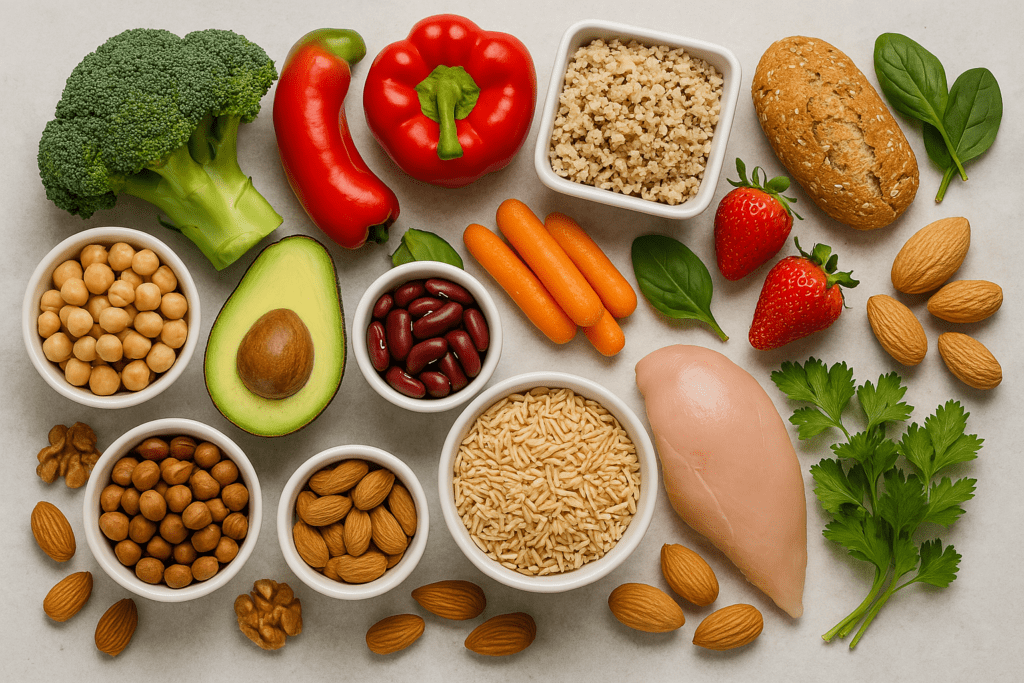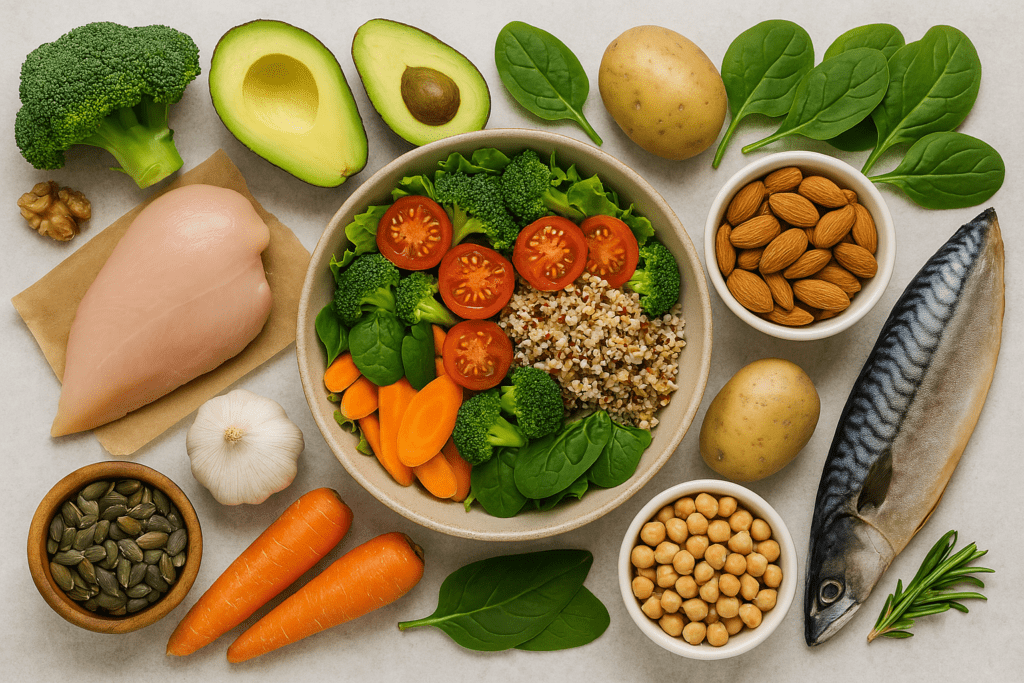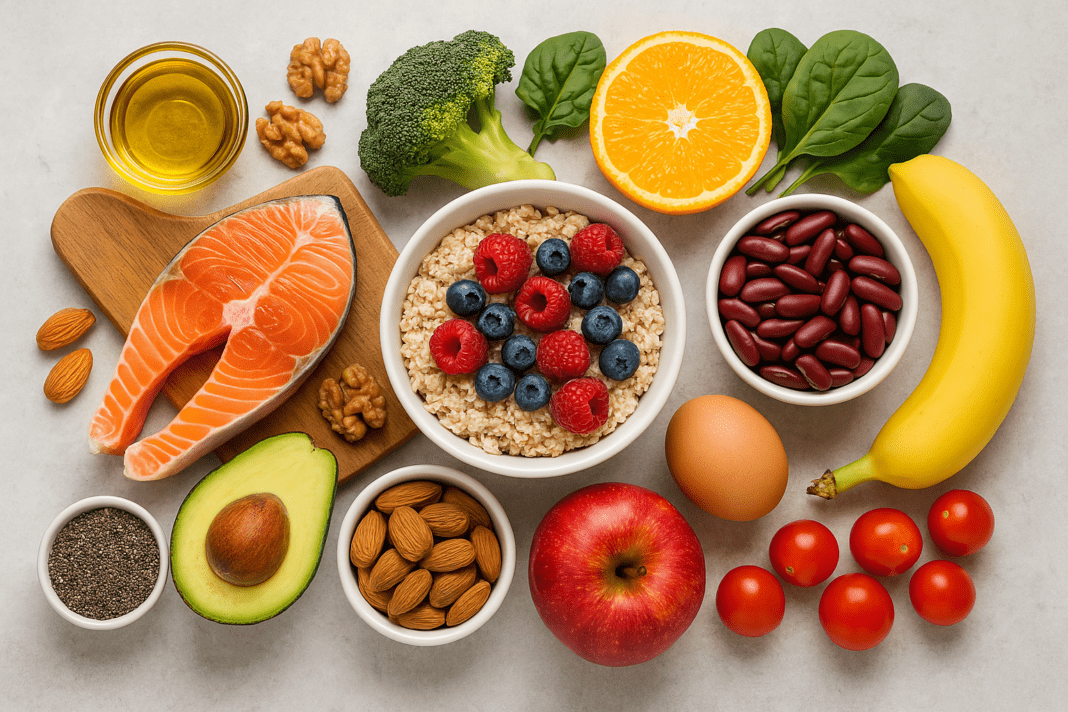Creating healthy family meals that satisfy both children and adults can often feel like an overwhelming challenge. In the whirlwind of school schedules, work demands, and the desire to nourish everyone with balanced food, busy parents frequently seek ways to simplify dinnertime without sacrificing nutrition or taste. In this comprehensive guide, we explore practical, evidence-based strategies for preparing nutritious dinner for children, including expert-approved healthy dinner ideas for kids that the whole family will enjoy. From incorporating whole ingredients to crafting creative recipes for kids that are healthy and fun, we’ll unpack how to turn family dinners into an opportunity for connection, growth, and health promotion.
You may also like: Smart Healthy Eating Tips for Busy Professionals: How to Stay Nourished When You’re Always on the Go
The Importance of Healthy Family Food for Lifelong Wellness
Consistent exposure to healthy family friendly meals during childhood plays a crucial role in establishing lifelong habits around nutrition, self-regulation, and food literacy. Research in pediatric nutrition underscores that children who regularly eat family meals rich in whole grains, lean proteins, fruits, and vegetables are less likely to develop chronic health conditions such as obesity, diabetes, and heart disease later in life. These shared meals are not just about food; they offer an environment for modeling positive eating behaviors and emotional well-being. When parents prioritize healthy family food choices, they help children learn to enjoy a variety of flavors and textures while internalizing the importance of nourishing their bodies. Establishing a culture of mindful eating at the dinner table strengthens family bonds and creates a dependable space for meaningful conversations and rituals.
Creating Balanced and Healthy Family Meal Ideas
Healthy family meal ideas begin with balance and variety. A well-rounded meal typically includes a lean source of protein, complex carbohydrates, and at least one or two servings of colorful vegetables. For example, grilled salmon served with quinoa and a medley of roasted vegetables delivers a nutrient-dense combination that appeals to both adults and children. For families with picky eaters, deconstructing meals can be helpful—offering components like shredded chicken, rice, cucumbers, and cherry tomatoes separately on a plate empowers kids to engage with healthy meals for kids at their own comfort level. Including healthy fats from sources like avocado, nuts, or olive oil supports cognitive development and satiety, ensuring children stay full and focused.

Meal Planning and Prep: Simplifying Healthy Family Cooking
One of the most effective strategies for maintaining consistency with healthy family cooking is meal planning. By dedicating time once a week to plan meals, grocery shop, and prep ingredients, parents can significantly reduce the stress of dinnertime decision-making. Preparing elements like chopped vegetables, cooked grains, and marinated proteins ahead of time enables the creation of healthy kid friendly meals in less than 30 minutes on busy weeknights. Freezer-friendly options such as turkey meatballs, vegetable-packed chili, and whole grain muffins can be batch-cooked and stored for quick assembly. Leveraging slow cookers, sheet pan dinners, and one-pot recipes also minimizes cleanup while maximizing nutritional value and flavor.
Creative and Healthy Recipes for Family of 4
Crafting healthy recipes for family of 4 does not mean resorting to bland or repetitive meals. Creativity in the kitchen helps keep children curious about new foods. For instance, a make-your-own taco night with ground turkey, beans, sautéed peppers, and guacamole offers personalization and hands-on participation that kids often enjoy. Another popular option includes homemade stir-fry with tofu or chicken, broccoli, bell peppers, and brown rice seasoned with low-sodium soy sauce and ginger. Even traditional comfort foods can be reimagined to fit a healthier profile, such as baked chicken tenders with whole grain breadcrumbs or mac and cheese made with pureed butternut squash and whole wheat pasta.
Making Healthy Meals for Big Families Budget-Friendly and Nutritious
Feeding a large household presents unique challenges, especially when aiming to prepare healthy meals for big families. Cost-conscious strategies are essential to make nutritious meals sustainable. Buying in bulk, choosing seasonal produce, and cooking with versatile staples like lentils, eggs, and oats can stretch both budget and menu variety. Preparing large batches of soups, casseroles, and stews allows for leftovers that can be repurposed into wraps or grain bowls. Rotating through a core set of healthy recipes for large families ensures efficiency without monotony. Teaching children about food waste reduction and involving them in tasks like washing produce or setting the table fosters a shared responsibility for health and sustainability.
Encouraging Healthy Eating Habits Through Kid-Friendly Presentation
Children are more likely to engage with healthy food ideas for kids when meals are visually appealing and interactive. Presentation plays a powerful role in encouraging young eaters to explore new foods. Brightly colored vegetables cut into fun shapes, fruit arranged like rainbows, and themed dinner nights can transform a simple meal into an inviting experience. Serving healthy dinners for kids in bento-style plates or muffin tins introduces novelty and keeps portions manageable. Letting children choose from a variety of ingredients at the table promotes autonomy and decreases resistance. Parents can also use storytelling, music, or games to create positive associations with mealtime.
Nutrition-Focused Strategies for Picky Eaters
Picky eating is a common concern in many households, but it doesn’t have to derail efforts to offer healthy dinners for children. Understanding that taste preferences evolve and exposure matters can help parents stay patient and persistent. Introducing new foods gradually, without pressure, alongside familiar favorites increases the likelihood of acceptance. For example, a child hesitant to eat steamed broccoli might try it roasted with a sprinkle of Parmesan or blended into a pasta sauce. Using dips like hummus or yogurt-based dressings can make vegetables more palatable. Empowering children to help cook, stir, or serve their meals increases their sense of ownership and curiosity around food. Ultimately, consistency and encouragement are more effective than bribes or ultimatums.
Healthy Dinner Ideas for Kids with Dietary Needs
Families navigating food allergies, intolerances, or special dietary preferences must take additional care when crafting healthy kid friendly dinners. Fortunately, an abundance of inclusive ingredients and substitutions make it easier than ever to meet these needs without sacrificing taste or nutrition. For dairy-free households, coconut or almond milk can replace cow’s milk in sauces and baked goods. Gluten-free grains like rice, quinoa, and cornmeal serve as nourishing alternatives to wheat-based products. Plant-based protein sources such as lentils, tofu, and chickpeas offer versatile options for vegetarian families. Creating healthy recipes for big families with diverse dietary considerations requires flexibility, but it can also open the door to greater creativity and cultural exploration.
Adapting Healthy Recipes for Family to Different Age Groups
Within a single household, meal preferences and nutritional needs can vary widely depending on age. Toddlers may require softer textures and more frequent exposure to new foods, while teenagers often need higher caloric intake and more autonomy in food choices. Parents can tailor healthy family meals by adjusting cooking methods and portion sizes while keeping the core ingredients consistent. For example, a hearty vegetable soup can be pureed for younger children and served chunky for older ones. Homemade grain bowls allow each family member to customize toppings based on their preferences. Keeping communication open and offering choices within limits helps accommodate individual needs without turning mealtime into a battleground.

Leveraging Leftovers to Create Healthy Family Friendly Meals
Transforming leftovers into appealing meals can be a powerful tool for reducing food waste and simplifying the weekly cooking routine. With a little creativity, last night’s roasted vegetables can become the base for a frittata, or leftover grilled chicken can be folded into tacos or wraps. Reinventing ingredients keeps meals fresh and encourages children to view food as a dynamic, enjoyable part of daily life. Creating a dedicated leftovers night each week also eases the mental load of constant meal planning. Parents can involve kids in brainstorming how to reimagine leftovers, turning it into a collaborative and educational experience that supports both health and resourcefulness.
Promoting Healthy Meals Kids Will Eat with Involvement and Education
Children are more likely to eat and enjoy healthy meals when they feel connected to the process of making them. Involving kids in meal selection, grocery shopping, and food preparation builds a sense of agency and investment. Reading simple recipes together, measuring ingredients, and learning basic cooking skills also support academic development in math, reading, and science. Parents can reinforce lessons about balanced eating through everyday conversations, encouraging children to notice how different foods make them feel. By cultivating a shared interest in healthy family dinners, mealtime becomes a space not only for nourishment but also for learning and growth. Teaching children about moderation, variety, and the joy of eating whole foods sets a strong foundation for lifelong wellness.
Streamlining Healthy Family Meal Recipes for Busy Weeknights
Time constraints are one of the most cited barriers to consistent healthy family cooking, particularly during busy school and work weeks. To overcome this hurdle, families can streamline their routines by choosing recipes that require minimal prep or rely on pre-chopped produce, canned legumes, or frozen vegetables. Pasta dishes made with whole grains and quick-cooking proteins like shrimp or beans are both satisfying and speedy. Breakfast-for-dinner options such as scrambled eggs with spinach and whole grain toast offer a fun and nutritious twist. Building a repertoire of easy healthy kid friendly dinners can ease the pressure of evening chaos while ensuring everyone eats well. Keeping a running list of favorites that meet the criteria for healthy meals kids will eat can also save time and eliminate decision fatigue.
The Role of Cultural and Seasonal Foods in Healthy Family Dinners
Incorporating cultural heritage and seasonal availability into meal planning enriches the experience of healthy family meals. Traditional recipes passed down through generations can be adapted with modern, health-conscious substitutions, preserving flavor while enhancing nutrition. For example, swapping white rice with brown rice in a stir-fry or using olive oil instead of butter in a Mediterranean dish can boost heart health. Seasonal produce not only supports local agriculture but also introduces children to the concept of eating with nature’s rhythm. Spring peas, summer tomatoes, fall squash, and winter root vegetables offer variety throughout the year and make family meals more vibrant and engaging. Teaching kids to appreciate cultural foods fosters diversity and inclusion while reinforcing the value of wholesome eating.
Cultivating Mealtime Routines for Consistency and Connection
Routines are essential for establishing consistency around healthy family dinners. Sitting down together, even for 20 minutes, several times a week can dramatically influence children’s attitudes toward food and family. Setting expectations around screen-free meals, shared conversation, and gratitude builds an environment where healthy eating becomes a natural part of life. Parents can further enhance this experience by involving children in setting the table, choosing music, or reflecting on their day. While perfection is unrealistic, aiming for regularity and presence at the dinner table helps build rituals that children carry into adulthood. These moments of connection, paired with nutritious food, create a powerful legacy of health, love, and care.
Frequently Asked Questions (FAQ): Healthy Family Meals Made Easy
1. How can families maintain variety in healthy family friendly meals without overwhelming their schedule or budget?
One practical way to maintain variety in healthy family friendly meals is by rotating a set of core ingredients in new ways each week. For example, ground turkey can be used for lettuce wraps, tacos, and stuffed peppers, each offering a fresh flavor profile while maintaining nutritional value. Investing in a few versatile pantry staples like canned beans, whole grains, and frozen vegetables allows for improvisation without breaking the bank. Variety can also be achieved through themed nights—such as “Meatless Monday” or “Stir-fry Friday”—which add rhythm and excitement to meal planning. Using a flexible framework to plan healthy family dinners helps families avoid boredom while staying within their means.
2. What are some advanced strategies for getting kids involved in preparing healthy family meals?
Beyond assigning simple kitchen tasks, consider integrating children into the planning and decision-making process for healthy family meals. For example, parents can allow kids to research one new vegetable each week and find recipes for kids that are healthy featuring that ingredient. Teaching children how to read nutrition labels or measure ingredients can build practical life skills and reinforce their relationship with healthy kids food. Families might also experiment with age-appropriate cooking tools, like child-safe knives or mini baking sets, which empower kids to engage more deeply. These experiences can help reduce mealtime resistance and make healthy kid friendly meals a collaborative adventure.
3. How do you navigate meal prep for multiple dietary restrictions while still creating healthy meals for big families?
When preparing healthy meals for big families with different dietary needs, batch cooking with flexible base ingredients is key. A meal like build-your-own rice bowls allows each family member to select toppings that suit their specific requirements while maintaining the spirit of a shared dinner. Substituting ingredients—such as using dairy-free cheese, gluten-free pasta, or legume-based protein—can accommodate most restrictions without needing to prepare multiple separate dishes. It’s also helpful to create a rotating list of healthy recipes for large families that can easily be adapted for allergens or preferences. Families can benefit from keeping a master ingredient list with acceptable substitutions to streamline weekly planning.
4. Are there psychological benefits associated with consistent healthy family dinners?
Yes, research increasingly supports that consistent healthy family dinners foster not only nutritional well-being but also emotional and psychological health. Children who participate in family friendly healthy dinners tend to exhibit higher self-esteem, better academic performance, and reduced likelihood of engaging in risky behaviors. Shared meals provide a predictable routine, creating a space where children feel safe to express themselves. Conversations at the table strengthen emotional intelligence and family cohesion, laying the foundation for lifelong healthy relationships. When paired with healthy family food, these shared moments promote overall family resilience.
5. How can parents encourage healthy eating habits when their child attends school or daycare where meals aren’t as nutritious?
Parents can help reinforce the value of healthy meals for kids by building a positive narrative around food at home. Educating children on how different foods support energy, focus, and growth empowers them to make informed choices outside the home. Preparing healthy dinner for kids that aligns with their favorite flavors can also reduce the appeal of less nutritious meals offered elsewhere. Packing lunches together is another way to extend healthy habits into the school environment, using healthy family meal recipes to create portable, kid-friendly options. Open communication about their daily meals encourages awareness and decision-making that lasts beyond the dinner table.
6. How do healthy recipes for family differ from adult-focused healthy meals in terms of nutritional balance?
Healthy recipes for family are often more balanced in macronutrients to support the differing needs of children and adults. For example, while an adult may thrive on a low-carb meal, growing children need a consistent source of complex carbohydrates for energy and brain development. A family meal might include a whole grain like farro or quinoa paired with lean protein and healthy fats to satisfy everyone at the table. Healthy dinner ideas for kids often prioritize texture and taste in a way that encourages exploration without added sugars or excess salt. Designing healthy kid friendly dinners with the whole family in mind ensures nutritional adequacy across life stages.
7. What role does culture play in developing healthy meal ideas for kids?
Cultural food traditions can be a powerful vehicle for introducing healthy meal ideas for kids that are rich in both nutrients and meaning. Dishes rooted in cultural heritage offer familiarity, pride, and sensory experiences that engage children beyond nutrition. Parents can modify traditional recipes with healthier cooking methods—such as grilling instead of frying or reducing sugar—to align with modern dietary goals. Involving children in the storytelling behind meals enhances their appreciation of diverse cuisines and supports long-term openness to trying new foods. This cultural integration helps build healthy family meal ideas that are inclusive, nourishing, and identity-affirming.
8. How can families with limited kitchen space still prepare healthy kid friendly dinners efficiently?
Even in compact kitchens, families can prepare healthy kid friendly dinners by maximizing counter space and investing in multi-functional tools. A slow cooker, air fryer, or electric skillet can help cook complete meals with minimal mess. Strategic batch prep—such as chopping vegetables all at once or cooking proteins in advance—reduces daily cleanup and streamlines the cooking process. Compact storage containers and stackable bins can make pantry ingredients more accessible for healthy family cooking in tight quarters. Creativity and simplicity often shine in small kitchens, proving that a lack of space does not preclude the creation of healthy recipes for family.
9. What are emerging trends in healthy food ideas for kids that families should be aware of?
Emerging trends in healthy food ideas for kids include the growing popularity of plant-based meals, global flavor integration, and allergy-aware ingredients. Innovative brands now offer clean-label snacks and meals designed to meet pediatric nutritional standards while maintaining taste appeal. Functional foods—those that offer added benefits like probiotics or brain-boosting omega-3s—are also becoming more common in healthy family friendly meals. Additionally, there’s a movement toward more sustainable packaging and locally sourced produce, allowing families to align their food choices with environmental values. Staying attuned to these trends helps parents offer healthy meals kids will eat without sacrificing convenience or ethics.
10. How can healthy recipes for family of 4 be adapted when guests are visiting or during the holidays?
When hosting guests or preparing holiday meals, healthy recipes for family of 4 can be scaled up without losing their nutritional intent. This might involve doubling recipes or adding complementary side dishes such as roasted vegetables or whole grain salads to extend meal volume. Offering a variety of options—such as both a plant-based and protein-rich dish—accommodates diverse dietary needs while preserving the balance found in everyday meals. Special occasions also provide an opportunity to introduce new healthy family meal recipes that feel festive but remain nourishing. With thoughtful planning, holiday meals can reflect the same principles as healthy dinners for kids while inviting everyone to the table with warmth and abundance.

Final Thoughts: How Healthy Family Meal Ideas Can Transform Daily Life
Making healthy family meals a daily reality is not just about what goes on the plate—it’s about the values, habits, and connections that grow around it. When parents embrace the journey of preparing healthy recipes for family and create an environment where food is respected, enjoyed, and shared, they lay the groundwork for lifelong wellness. Whether you’re navigating dietary needs, budget constraints, picky eaters, or time pressures, there are always opportunities to adjust, adapt, and celebrate small wins. By focusing on family friendly healthy dinners that nourish both body and soul, families can transform mealtime from a stressful task into a cherished tradition. Ultimately, the consistent practice of preparing and sharing healthy dinner for kids becomes a powerful investment in their physical health, emotional well-being, and relationship with food for years to come.
family nutrition tips, balanced meals for children, kid-friendly nutrition, healthy eating for families, meal planning for parents, nutritious weeknight dinners, wholesome home cooking, picky eater solutions, child development and diet, smart grocery shopping, easy dinner recipes, cooking with kids, healthy lifestyle habits, whole food meals, plant-based family meals, quick nutritious dinners, seasonal cooking ideas, feeding growing kids, mindful family eating, teaching kids healthy habits
Further Reading:
15 Healthy Recipes You Can Cook with Your Kids
A Month of Healthy Meals for Kids
30-Minute Meals Your Family Will Love
Disclaimer
The information contained in this article is provided for general informational purposes only and is not intended to serve as medical, legal, or professional advice. While NewsHealthWatch strives to present accurate, up-to-date, and reliable content, no warranty or guarantee, expressed or implied, is made regarding the completeness, accuracy, or adequacy of the information provided. Readers are strongly advised to seek the guidance of a qualified healthcare provider or other relevant professionals before acting on any information contained in this article. NewsHealthWatch, its authors, editors, and contributors expressly disclaim any liability for any damages, losses, or consequences arising directly or indirectly from the use, interpretation, or reliance on any information presented herein. The views and opinions expressed in this article are those of the author(s) and do not necessarily reflect the official policies or positions of NewsHealthWatch.

